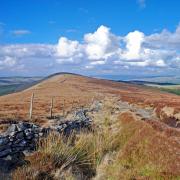Lucy Bamford, senior curator of art at Derby Museums Trust, dicusses a vivid piece by Tomás Harris (1908–1964)
If you should chance to call in to The Museum and Art Gallery in Derby, you may be surprised to discover a whole new vista has opened up before you. A colourful and in some cases surprising selection of landscape paintings drawn from the museums’ collection is currently on view. Many are on show for the first time in over a decade. With works by local and national artists, from the 18th to the 20th centuries, it is a display that celebrates aspects of our enduring – if ever-changing – relationship with the natural world.
Among old favourites by local artists George Turner and John Fineran, an unexpected shot of bright colour disturbs the familiar rhythms of the Derbyshire landscape. Jagged violet hills surround a grove of trees, their gnarled and twisted forms emerging from the splintered arid earth. An apparently impossible rainbow of colours, it is a vivid painting that captures the heat and sunlight of the Mediterranean. The artist, Tomás Harris (1908–1964), had roots in Spain through his mother, Enriqueta Rodriquez. Although the Harris family lived in London, ties to the country remained close with a gallery devoted to the works of Spain’s masters being established by Tomás’s father. Continuing the family business, Tomás went on to become one of Britain’s foremost experts on Spanish art, whilst winning a scholarship to the Slade School of Art in London to hone his own artistic skills. By 1962, and the completion of his ‘Landscape with Grove of Trees’, Tomás had retired to Majorca. It is perhaps here, among the mountains and valleys of the Sierra de Tramontana, near his home at Andraxt, that Tomás found the inspiration for this scene, as he did for so many of his later landscapes.
Writing after the artist’s death in 1964, the art historian Anthony Blunt – his dual identity as a Soviet spy not yet unmasked – described the ‘nervous intensity’ of Tomás’s work ‘which reflected the strain under which Tomás was living and working.’ He continued, ‘the technique [was] strongly reminiscent of Van Gogh, but, if one suggested this to him, he absolutely denied ever having intended to imitate this artist.’ Blunt was writing with the benefit of close personal insight. At the outbreak of World War II, Tomás was invited to work for British Intelligence, alongside his friend Blunt, Guy Burgess, and Kim Philby. Whilst the names of these three traitors are now synonymous with the story of the Cambridge Spies, Tomás achieved fame as a leader of what has been described as the greatest double-cross operation of the war – ‘Operation Garbo’ – which misled the Germans about the Allied plans for the invasion of France, and thus secured the success of the D-Day Landings. Tomás was awarded an OBE in 1945 in recognition of his contribution.
A retrospective of Tomás’s work was held at the Courtauld Institute of Art in 1975, with many pieces subsequently donated to public museums and galleries by the artist’s family. Derby Museum was among the fortunate recipients of this scheme, which included The Courtauld Gallery, University College, London, the University of Edinburgh, Leamington Art Gallery, Colchester Museums, and the Royal Free Hospital. This rich legacy will ensure that future generations can enjoy the work of this fascinating, if perhaps underrated, artist.



























